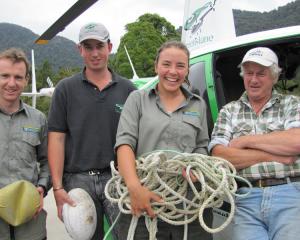Climate change is the biggest threat to the Great Barrier Reef, officials say on the heels of a report that also found some of Australia's other unique flora and fauna are being negatively affected by the changing environment.
The independent government-commissioned report found wedge-tailed shearwaters are reproducing less because of higher sea temperatures; the population of the mountain pygmy possum is vulnerable to drought and new predators as its snow cover melts away earlier in the year; and eucalyptus trees in Tasmania are dying off because of a continuing lack of rain.
The findings were worrying because Australia is one of world's most biologically diverse countries, and up to 80 percent of its plants and animals are found nowhere else.
"This report reinforces what we already know - that our birds and animals and their native habitat is threatened by climate change and the rate of extinction is likely to increase unless we take action," Environment Minister Peter Garrett said at the opening of an ecology conference in Brisbane.
Great Barrier Reef Marine Park Authority Chairman Russell Reichelt said officials were launching a new plan to raise awareness of the impact of weather and humans on the famous marine habitat. The study found that mass coral bleaching events continue at the reef.
"The reef is actually already experiencing pressures," Reichelt said.
"This is not some hypothetical. Since 1998 we've had mass coral bleaching on the Barrier Reef so it has been experiencing those pressures now for at least 10 years. The pressures are set to increase; we need to take the pressure off the reef."
Coral bleaching is caused by warmer waters, which cause the stressed organisms to expel the colourful algae living in their tissues, leaving a whitish colour.
Coral bleaching that lasts more than a week can kill the organisms, since they rely on the algae for sustenance, leading to the loss of reef habitat for numerous marine species.
Reichelt said the new strategy includes reducing the carbon footprint of tourism operators, improving energy efficiency and monitoring changes to the coral.
The report studied climate change factors such as increases in air and sea temperatures, the rise in sea levels, altered rainfall and runoff patterns and elevated carbon dioxide in the atmosphere and the ocean.
It was the first major scientific analysis of what climate change will mean for Australia's unique biodiversity, Garrett said.
It said significant changes in government policies and public perception will be required to address the changing biodiversity.
"Much is at stake in dealing effectively with the climate change challenge," the independent expert advisory group behind the report wrote.
"A management priority must be to maintain the provision of ecosystem services through a diversity of well-functioning ecosystems, some of which may have no present-day equivalent."
The study recommended a national vision for biodiversity management, conservation efforts and commitment to rapid and deep cuts in global greenhouse gas emissions.




